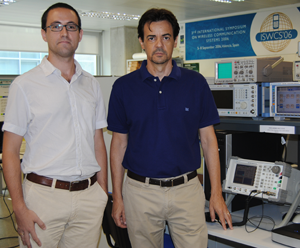The Universitat Politècnica de Valencia, through the Mobile
Communication Group (MCG), is the only Spanish University that participates in
this project, which is coordinated by Ericsson. The rest of participants are telecommunications manufacturers, network
operators, the automotive industry and the academic sector: Aalborg University,
Aalto University, Alcatel-Lucent, Anite, BMW Group Research and Technology,
Chalmers University of Technology, Deutsche Telekom, NTT DOCOMO, France
Telecom-Orange, Fraunhofer-Gesellschaft, Huawei Technologies GmbH, KTH – Royal
Institute of Technology, National and Kapodistrian University of Athens, Nokia
Corporation, Nokia Siemens Networks, University of Oulu, Poznan University of
Technology, RWTH Aachen, Institut
Mines-Télécom,
Telecom Italia, Telefónica, University of Bremen and University of
Kaiserslautern.
The
reason that led to the METIS consortium to follow this line of research is basically that the smartphone
subscriptions will grow from 1.2 billion in 2012 to 4.5 billion by 2018. This
in turn means an equally astonishing increase in mobile data traffic, which
doubled between Q1 2012 and Q1 2013, and by the end of 2018 it is expected to
be 12 times as large as it was at the end of 2012. Furthermore, traffic will be
driven by a mix of communication between humans and machines, which need to
access and share information efficiently, comfortably and safely. The advent of
the Internet of Things, as well as other new and innovative applications, will
see tens of billions of connected devices and an unprecedented diversity of
requirements and use cases associated with wireless connectivity.
METIS will have to
respond to this increase in traffic volume, by increasing capacity and by
improving efficiency in energy, cost and spectrum utilization. Further, the
numbers of devices and varieties of use cases and requirements will necessitate
mobile and wireless communication solutions with significantly increased
versatility and improved scalability. METIS will lay the foundation for the
future 5G mobile and wireless communications system, consisting of
the evolution of currently-existing wireless technology and any new wireless
technology needed to fully enable the networked society. METIS will develop a
system concept that delivers the necessary efficiency, versatility and
scalability. The project will investigate key technology components supporting
the system, and will also evaluate and demonstrate key functionalities.
Furthermore, METIS will provide a proof-of-concept by means of simulations and
test-beds. In particular, METIS will demonstrate through hardware test-beds key
technology components developed in the project.
In the socio-economic
aspect, the consortium METIS will help the mobile and wireless communications
industry to expand markets and to create new business opportunities for the
mobile communications industry, and also lever opportunities in other
industries that can benefit from a vastly-increased mobile connectivity.
European industry will benefit from METIS on the economic front by gaining
prime-mover status due to the innovation generated by the project. METIS will
offer new wireless technology concepts and novel topics (e.g. massive-machine
communications, ultra-dense networks, and ultra-reliable communication). These
novel topics will support services and application areas and open new business
opportunities.
Since the launch of
METIS in November 2012, the consortium has defined 5 scenarios that reflect the
future challenges and will serve as guidance for further work:
1.
“Amazingly fast”, focusing on high data-rates
for future mobile broadband users,
2.
“Great service in a crowd”, focusing on
mobile broadband access even in very crowded areas and conditions,
3.
“Ubiquitous things communicating”, focusing
on efficient handling of a very large number of devices with widely varying
requirements,
4.
“Best experience follows you”, focusing on
delivering high levels of user experience to mobile end users, and
5.
“Super real-time and reliable connections”,
focusing on new applications and use cases with stringent requirements on
latency and reliability.
In words of Narcis
Cardona, head of the MCG, “The
objective is to anticipate how
every proposed idea will work in a
possible scenario of 5G”.
METIS has derived a
challenging set of requirements from these scenarios, which can be summarized
as:
1.
Ten to one hundred times higher typical user
data rate where in a dense urban environment the typical user data rate will
range from one to ten Gbps,
2.
One thousand times more mobile data per area
(per user) where the volume per area (per user) will be over 100 Gbps/km2
(resp. 500 Gbyte/user/month),
3.
Ten to one hundred times more connected
devices,
4.
Ten times longer battery life for low-power
massive machine communications where machines such as sensors or pagers will
have a battery life of a decade,
5.
Support of ultra-fast application response
times (e.g. for tactile internet) where the end-to-end latency will be less
than 5 ms with high reliability, and
6.
A key challenge will be to fulfill the
previous requirements under a similar cost and energy dissipation per area as
in today’s cellular systems.
Moreover, the MCG is
working on the use of mobiles as nodes which cooperate in the transmission to
other devices. This would result in a significant increase of
transmission speed. In this subject, professor José F.
Monserrat points that “Despite of the fact that the progress
in this line is only theoretical because this is a very innovative research line, we
already have an estimate of the
gain that could be reached, which
is around 20%.”
In the coming months,
METIS will continue to lay the foundation of the 5G mobile and wireless
communications system. In particular, METIS is developing and evaluating the key
technology components of 5G systems, and will integrate the technical
components that address the requirements of this system.

